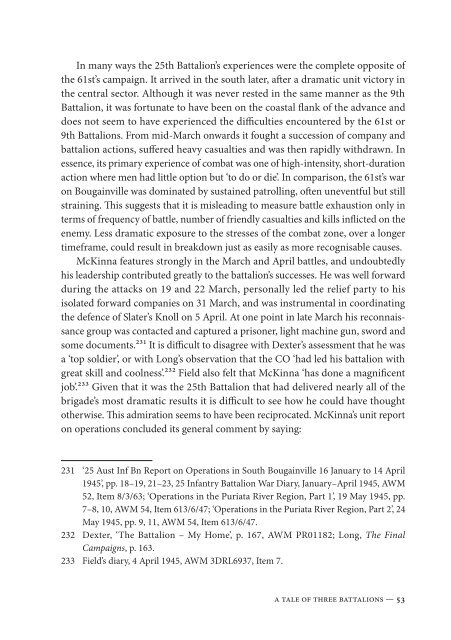View the pdf - Australian Army
View the pdf - Australian Army
View the pdf - Australian Army
Create successful ePaper yourself
Turn your PDF publications into a flip-book with our unique Google optimized e-Paper software.
In many ways <strong>the</strong> 25th Battalion’s experiences were <strong>the</strong> complete opposite of<strong>the</strong> 61st’s campaign. It arrived in <strong>the</strong> south later, after a dramatic unit victory in<strong>the</strong> central sector. Although it was never rested in <strong>the</strong> same manner as <strong>the</strong> 9thBattalion, it was fortunate to have been on <strong>the</strong> coastal flank of <strong>the</strong> advance anddoes not seem to have experienced <strong>the</strong> difficulties encountered by <strong>the</strong> 61st or9th Battalions. From mid-March onwards it fought a succession of company andbattalion actions, suffered heavy casualties and was <strong>the</strong>n rapidly withdrawn. Inessence, its primary experience of combat was one of high-intensity, short-durationaction where men had little option but ‘to do or die’. In comparison, <strong>the</strong> 61st’s waron Bougainville was dominated by sustained patrolling, often uneventful but stillstraining. This suggests that it is misleading to measure battle exhaustion only interms of frequency of battle, number of friendly casualties and kills inflicted on <strong>the</strong>enemy. Less dramatic exposure to <strong>the</strong> stresses of <strong>the</strong> combat zone, over a longertimeframe, could result in breakdown just as easily as more recognisable causes.McKinna features strongly in <strong>the</strong> March and April battles, and undoubtedlyhis leadership contributed greatly to <strong>the</strong> battalion’s successes. He was well forwardduring <strong>the</strong> attacks on 19 and 22 March, personally led <strong>the</strong> relief party to hisisolated forward companies on 31 March, and was instrumental in coordinating<strong>the</strong> defence of Slater’s Knoll on 5 April. At one point in late March his reconnaissancegroup was contacted and captured a prisoner, light machine gun, sword andsome documents.231 It is difficult to disagree with Dexter’s assessment that he wasa ‘top soldier’, or with Long’s observation that <strong>the</strong> CO ‘had led his battalion withgreat skill and coolness’.232 Field also felt that McKinna ‘has done a magnificentjob’.233 Given that it was <strong>the</strong> 25th Battalion that had delivered nearly all of <strong>the</strong>brigade’s most dramatic results it is difficult to see how he could have thoughto<strong>the</strong>rwise. This admiration seems to have been reciprocated. McKinna’s unit reporton operations concluded its general comment by saying:231 ‘25 Aust Inf Bn Report on Operations in South Bougainville 16 January to 14 April1945’, pp. 18–19, 21–23, 25 Infantry Battalion War Diary, January–April 1945, AWM52, Item 8/3/63; ‘Operations in <strong>the</strong> Puriata River Region, Part 1’, 19 May 1945, pp.7–8, 10, AWM 54, Item 613/6/47; ‘Operations in <strong>the</strong> Puriata River Region, Part 2’, 24May 1945, pp. 9, 11, AWM 54, Item 613/6/47.232 Dexter, ‘The Battalion – My Home’, p. 167, AWM PR01182; Long, The FinalCampaigns, p. 163.233 Field’s diary, 4 April 1945, AWM 3DRL6937, Item 7.A tale of three battalions — 53
















